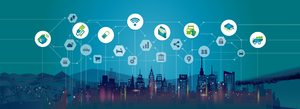EERAdata
Contents
EERAdata - Towards a FAIR and open data ecosystem in the low carbon energy research community
Transparent, re-usable, and integrated energy data enable society to choose, monitor, and implement sustainable transition pathways. It is not only a prerequisite for people to have ownership over the changes, but it is also offering huge potential for industrial and social innovation. The majority of energy databases are not fit for this purpose, which the project aims to change. The consortium develops, tests, and implements a FAIR and open data ecosystem in the energy field. FAIR stands for F-findable, A-accessible, I-interoperable, and R-re-usable. The EU-funded EERAdata project builds a pool of data stewards to guide the community towards fit-for-purpose data practices.
EERAdata logo and key visual
The elements of the logo include data points - symbolizing databases or data platforms - and a data folder which are connected through the feed symbol. All stand for the idea of EERAdata to support FAIR and open data. The folder furthermore is a nostalgic reminder of the grand library catalogs to search for books, all of them are masterpieces on their own.List of project partners
- HVL - Western Norway University of Applied Sciences
- IUE - Izmir University of Economics
- AIT - Austrian Institute of Technology
- GIG - Central Mining Institute
- EERA - European Energy Research Alliance
Objectives of EERAdata
Overall objective: Develop, explore and test a FAIR and open data ecosystem through broad involvement of energy communities and through its implementation with selected use cases.
Specific objectives:
- Promote the opening and FAIRification of low carbon energy research databases.
- Develop a community platform as an entry point for both, providers of energy data and users of energy data .
- Build technical, operational and financial capacities for the management of FAIR and open data in and with the low carbon energy research community.
- To Coordinate the management of data in the energy field in EERA and beyond by fostering initiatives in industrial and scientific communities in the frame of EOSC.
Use cases in EERAdata
Definition: Use cases are an exercise for testing and refining the general approach towards FAIRification and opening of databases as well as to testing and refining the community platform. Use cases constitute practical commitments for implementation (PCI), i.e. the FAIRification and opening of data. Through exercises, the status quo of FAIR/O data principles in each use case is advanced by:
- Identifying taxonometric elements and metadata common among different domains of the energy system. Proper metadata will enable separating expert knowledge (and expert interest) from general knowledge and general interest, allowing coarse-grained and fine-grained navigation.
- Linking these metadata standards to existing metadata standards in other domains. Example: Weather-related data are integral to the efficient operation of PV, wind technology, or district heating. The assignment of geo-tagged information to low carbon energy technology data is thus the way forward. EERAdata will link energy domain metadata with metadata defined by ISO 19115 Geographic Metadata Information.
- Exploring a variety of challenges towards FAIRification and Opening of data. Use cases provide a means to test the EERAdata concept towards FAIRification and the opening of data. Therefore, use cases are chosen to cover, on the one hand, low hanging fruits to demonstrate do-ability, promote the FAIR/O data principle implementation and showing associated benefits for the low carbon energy research community. On the other hand, EERAdata also includes use cases where the concept is challenged, because FAIRification and opening activities are still in their infancy.
- Broad testing and application to enable trans-disciplinary research combining data from different domains and at different scales. Use cases are at the same time selected to cover wider aspects of the low carbon energy transformation, exploring different sub-domains. This ensures a broad testing and application of the FAIR/O ecosystem as well as the community platform.
- Gender as a cross-cutting issue, see Gender for more details.
Selection: Altogether 4 use cases were selected:
| Use case 1 | Use case 2 | Use case 3 | Use case 4 |
|---|---|---|---|
| Buildings efficiency | Power transmission & distribution networks | Material solutions for low carbon energy | Low carbon energy and energy efficiency policies |
| IMG | IMG | IMG | IMG |
Furthermore, EERAdata works on a "blue-print" for a Data Management Plan for low carbon energy projects.
